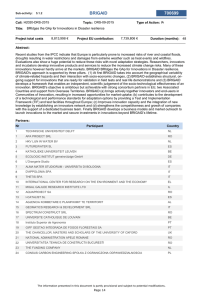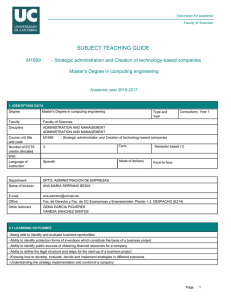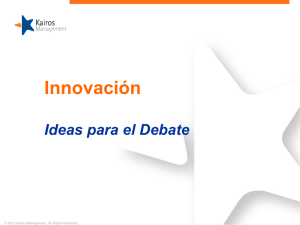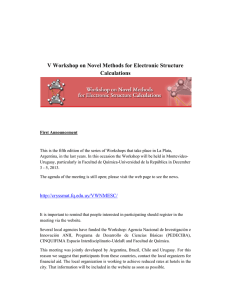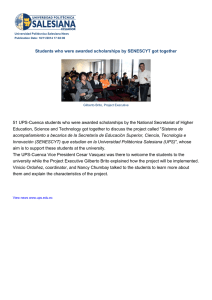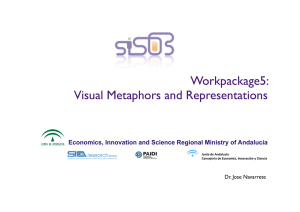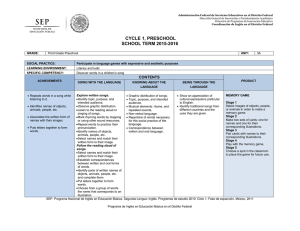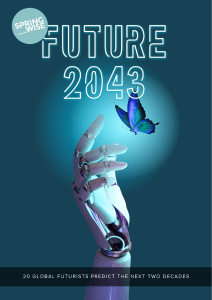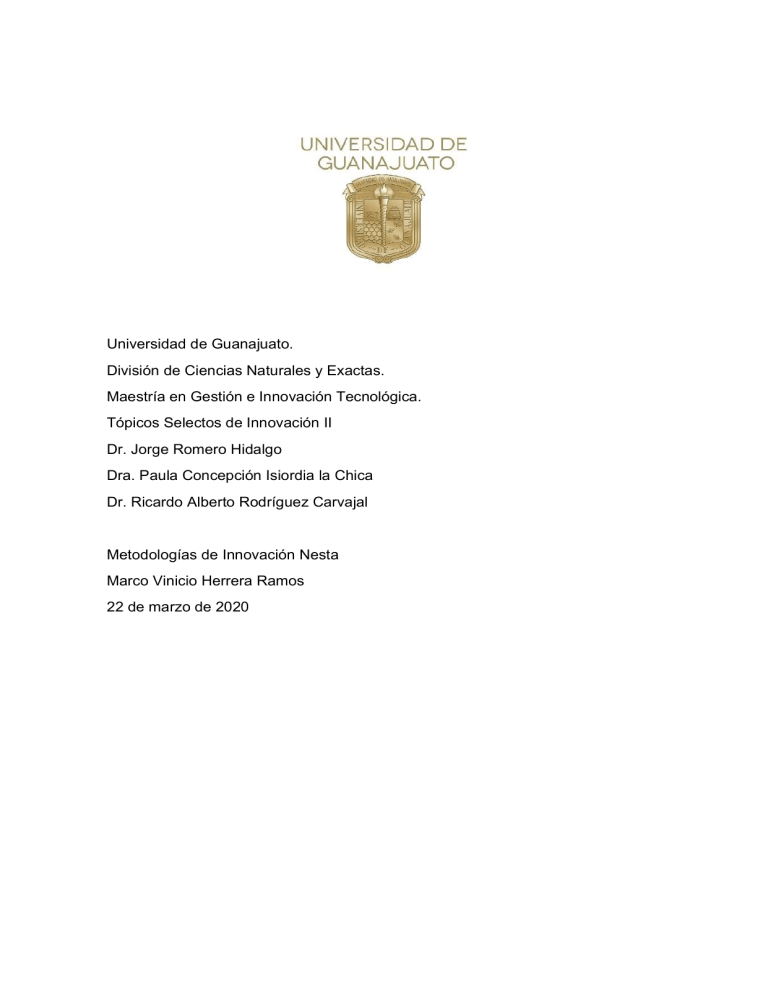
Universidad de Guanajuato. División de Ciencias Naturales y Exactas. Maestría en Gestión e Innovación Tecnológica. Tópicos Selectos de Innovación II Dr. Jorge Romero Hidalgo Dra. Paula Concepción Isiordia la Chica Dr. Ricardo Alberto Rodríguez Carvajal Metodologías de Innovación Nesta Marco Vinicio Herrera Ramos 22 de marzo de 2020 1. Oportunidades y retos 2. Generación de ideas 3. Desarrollo y prueba. 4. Desarrollar el caso 5. Entrega e implementación 6. Crecimiento y escalamiento 7. Cambio de sistemas Espiral de Innovación Ciclo Disparador de tecnología Pico de saturación de expectativas Sima de desilución Pendiente de supervivencia Plataforma de producttividad estabilizadas Marco General A highly selective admissions process / Typically fee-based A focus on cohorts or ‘classes of startups rather than individual companies. Mentoring or other business training / Technical facilities ntense and time-limited support, usually lasting between 3 and 12 months. Training Mentoring Business support Selective Programas de Aceleración Nesta´s Role Early investments in a range of startup Seedcamp to Springboard interested in the emerging trend of seed accelerator ow cost and high impact way to develop startups and entrepreneurs. Works with policymakers Is an emerging approach that is proactive, iterative and responds to evolving markets Developing new ways of thinking about regulation, and working to show what it means in practice. Anticipación Regulatoria We are beginning to see a radical shift in both the theory and practice of regulation with the emergence. Provides a set of behaviours and tools to help regulators and government identify, build and test solutions to emerging challenges. Three modes of action have appeared in this burgeoning area: advisory, adaptive and anticipatory approaches. • Inclusive and collaborative Future-facing Proactive Iterative mindset Outcomes-based Decentralised experimentation Offer a reward to whoever can first or most effectively meet a defined challenge. Aim to tap into and engage the broadest possible community of innovators in the solving of a specific problem or challenge. Offer a financial reward for the first or best solution to a problem, attract the best innovators, and give them the support they need to compete. Prizes specify a problem to be solved and incentivise solvers . Published criteria define what success looks like, Can incentivise new thinking Reward the best solutions Can also bring together innovators and help them thrive. Help innovators by raising their profile Bringing them into contact with expertise, investment and new customers cash prize. Prizes can unlock systemic change They don t just create solutions to a narrow technical problem They can raise awareness Done right, they can create whole new technologies and markets Challenge Prizes Challenge prizes are particularly suited to solving problems: Problems that are defined well Problems that would benefit from the fresh thinking Problems where a prize could attract new innovators Problems where the additional funding and attention the prize would bring Problems where the solution could thrive in the market There are four main types of crowdfunding Donation-based Rewards-based Equity-based Lending-based (AKA P2P-lending) At the heart of most crowdfunding is the idea of a ‘platform Pitch Screening Pitch goes live Public pledge money Project development Crowfounding Is a way of trying something new while putting in place the necessary structures to find out if it works. several ways to experiment: working closely with the people who will use the end solution Should always be designed in a way that best answers the question or hypothesis set Four types of experiments Randomised controlled trials (RCTs) A/B tests use RCTs to test small tweaks in design or implementation, often online. Rapid-cycle experiments are a new way of improving how innovations are designed and implemented Design exploration and experimentation takes an experimental approach to developing or testing innovations, Experimentación Futures is an umbrella term for tools like horizon scanning, trend analysis, scenario planning and Delphi. understanding about the forces shaping the future what surprises could be on the horizon what actions could be taken today Futures Starting with horizon These insights can be organised in informative and creative ways to help people imagine different futures. Explore and propose possible, probable and preferable futures e brought to life through the development of future scenarios, by telling stories through science fiction and personas, and even creating objects from the future using speculative design methods. 1. Gathering intelligence about the future (for example, 7 Questions and the Delphi method). 2.Exploring the dynamics of change (for example, Driver Mapping and the Axes of Uncertainty). 3. Describing what the future might be like (for example, Visioning and SWOT Analysis). 4. Developing/testing policy and strategy (for example, Backcasting and Roadmapping). Compendio de Innovación Nesta Seeks to deliver positive social and/or environmental benefits Providing capital to organisations that develop products and services. Or that use their operational infrastructure to make a positive difference to society or the environment. Investors using a private equity model become very involved in the running of the company, often joining the Board and requiring regular reporting of progress across financial and impact key performance indicators (KPIs). Some investors choose to target market-rate returns alongside impact Nesta Impact Investments has invested in 13 companies and one social impact bond. Impact Investment Uses new data sources, data science methods and visualisation tools to help policymakers navigate complex innovation systems: Where is innovation happening? Who is doing it? What do we do about it? Some of the tools Identify burning policy questions and evidence needs using structured methods for stakeholder engagement. Collect data from business websites, open repositories about scientific research and social media websites to get a timelier and more detailed picture of how innovation happens. Analyse millions of descriptions of innovation using Natural Language Processing (NLP) methods to better understand the technologies used and the problems addressed We use network science to visualise the structure of collaboration networks, identify gaps between communities and recommend interventions to encourage the exchange of ideas Innovation Mapping Questions Sources Methods Outputs Is a structured innovation process, combined with coaching support Enables frontline staff from across a public services system Collaborate and rapidly experiment with new ways of working. Achieve better results for people and communities. Empowering those on the frontline. Are intensive periods of action and collaboration that typically involve representatives from health, social care and voluntary organisations Frontline practitioners and citizens set ambitious goals and develop and test creative solutions in real conditions. Design Human-centred design and user-led innovation Leadership development practice Adaptive and Network leadership Quality Improvement Plan-Do-Study-Act, and Evidence-based practice. Group dynamics and team effectiveness Deploying a range of facilitation and coaching, and behaviour change techniques 100 Day Challenge Phase 1: Create the conditions and mobilise the teams. Phase 2: Take action, experiment and learn Phase 3: Grow the ideas and build the movement Developing a range of innovative ideas: Typically, within national/local strategic frameworks, and focusing on new care pathways, policies, products, processes and roles. Achieving learning and results. Shifts in culture, mindset and relationships: Stimulating new ways of working across organisational and professional boundaries, and with people and communities, Is a low-cost, low-risk way of developing, testing, and improving ideas at an early stage. A model version of a product or service elicits feedback and remodelling before extensive resources are committed to implementation. Prototyping Prototyping enables innovators to experiment, evaluate, learn, and adapt an idea, so they can refine it into something even better Prototyping grants are designed to support innovators to take a structured and iterative approach to testing their new ideas and developing them as they go Prototyping is not an alternative to piloting Are teams, units and funds dedicated to structuring and embedding innovation methods and practice in government to tackle social and public problems. The approach typically includes Scanning for and identifying key issues, priorities and tasks Developing ideas that impact on these areas Testing and prototyping solutions Creating new entry points or routes to drive systems change or have a greater impact. Public and Social Innovations labs Innovation labs are distinguished by: The methods they use, such as design, data, or behavioural economics The field in which they work, such as education or healthcare Where they focus their efforts, from upstream to downstream, in the innovation process How they work, with some innovating in practice, such as by undertaking experiments or using open innovation methods, to those who primarily support and fund others The extent to which they are directly involved with government, from being based inside to operating at arm s length, to others that are entirely separate. Scaling is the process of supporting high impact social ventures to reach more people and fulfil their potential achieving greater influence. Grant finance is used to help accelerate this process for non-profit ventures. Scaling grants for Social innovations We see scaling as a distinct stage in the process of developing a social innovation. • Building a delivery network – franchising, licensing, federations, and issuing kitemarks for quality are all used commercially Strategic partnerships – mergers, acquisitions, using a larger organisation s network or back office expertise nfluencing and advising – moving into a role of advisor rather than deliverer in order to spread your message but not grow your organisation Scalable social innovations tend to be ones that: Are relevant beyond their initial context. Are relatively simple Are clearly better than the alternatives. Don t rely solely on the talents of specific individuals. Helps to answer an important innovation question: Is an innovation doing any good? Is it even doing harm? Is the status quo just as good as the innovation? Standards provide a structure Level 1 You can describe what you do and why it matters, logically, coherently and convincingly Level 2 You capture data that shows positive change, but you cannot confirm you caused this Level 3 You can demonstrate causality using a control or comparison group Level 4 You have one + independent replication evaluations that confirms these conclusions Level 5 You have manuals, systems and procedures to ensure consistent replication Standards of Evidence The first step of that journey asks you to describe what you plan to do A Theory of Change helps you to be explicit about your goals It s a first step in designing an effective evaluation The next stages of that evidence journey ask that you try and capture some data to see if you are making a significant difference. The more advanced levels of the journey involve repeating the success of your innovation
